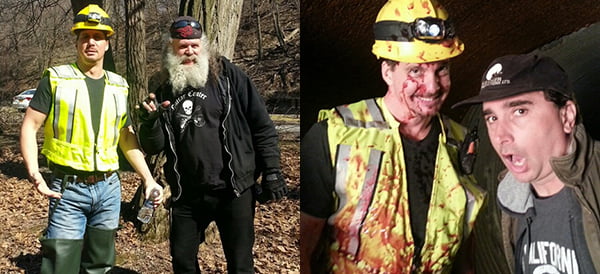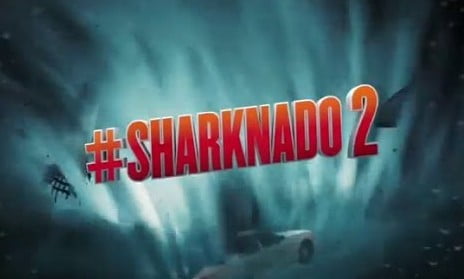I giggled out loud when I received the email from The Asylum offering me a cameo role in “Sharknado 2.” And then I saw that it filmed in Buffalo in five days! A Sunday, to be exact, on a weekend I was already booked at a con (A&G Ohio). After a flurry of emails it was set that I’d fly to Ohio for a Friday and Saturday appearance at the con, then fly out at 5 am Sunday to Buffalo, NY.
Two plane rides later, I had gotten my rental car, checked into my hotel and drove to the location. An hour later I was transformed into a NYC MTA worker and quickly tried to pick-up Michael Dugan’s accent (my fellow MTA worker).

With the FX guy / with director (Anthony C. Ferrante)
Six hours later, after many takes of running with waders on (and flailing like a little girl because my boots were filled with water from the first take), I wiped the blood and guts off my face and headed back to my hotel for dinner… Fish, to be exact.
And now I am a part of twitter/television history. God bless you, Asylum & SyFy.

Sharknado 2!

The Phenomena of Sharknado and Its Sequels
Introduction
The “Sharknado” series has become a cultural phenomenon since its debut in 2013. Combining the outrageous concept of a tornado filled with sharks with over-the-top action and campy humor, the franchise has garnered a significant following. This article explores the origins of “Sharknado,” its sequels, and the impact it has had on popular culture.
Origins of Sharknado
“Sharknado” was produced by The Asylum, a company known for creating low-budget, direct-to-video films. The film was directed by Anthony C. Ferrante and written by Thunder Levin. Premiering on the Syfy channel, the movie quickly gained attention for its absurd premise: a tornado scooping up sharks from the ocean and unleashing them on Los Angeles.
Plot and Reception
The first “Sharknado” movie follows Fin Shepard (Ian Ziering), a bar owner and surfer, as he battles a freak weather phenomenon that brings a swarm of deadly sharks to Los Angeles. With the help of his ex-wife April (Tara Reid) and a group of friends, Fin must find a way to survive the onslaught and save the city. The film’s blend of B-movie tropes, ridiculous special effects, and self-aware humor struck a chord with viewers, leading to a significant social media buzz and widespread media coverage.
The Sequels
Following the unexpected success of “Sharknado,” Syfy and The Asylum quickly greenlit a sequel. Over the next several years, the “Sharknado” franchise expanded to include five sequels, each escalating in scale and absurdity.
Sharknado 2: The Second One (2014)
Set in New York City, the second installment sees Fin and April battling another shark-filled storm. The sequel features numerous celebrity cameos, including Kelly Osbourne, Billy Ray Cyrus, and Al Roker. The film was a hit, drawing even more viewers than the original and solidifying the franchise’s cult status.
Sharknado 3: Oh Hell No! (2015)
In “Sharknado 3,” the action moves to the East Coast, with Fin and April facing sharknados in Washington, D.C., and Orlando, Florida. The film includes appearances by David Hasselhoff and Bo Derek, among others. By this point, the franchise had fully embraced its reputation for outrageousness, with increasingly improbable scenarios and over-the-top special effects.
Sharknado: The 4th Awakens (2016)
The fourth film, a parody of “Star Wars: The Force Awakens,” continues the tradition of escalating absurdity. Set five years after the previous film, “The 4th Awakens” features new sharknado variations, such as “nuclear sharknados” and “oilnados.” The cast includes returning favorites as well as new characters, with a storyline that spans Las Vegas and Texas.
Sharknado 5: Global Swarming (2017)
Taking the action international, “Sharknado 5” sees Fin and his allies traveling the world to stop a global sharknado outbreak. The film includes scenes set in London, Tokyo, and Rome, with cameos by Fabio, Tony Hawk, and Olivia Newton-John. The franchise’s increasing reliance on global settings and high-profile cameos highlights its growing cultural impact.
The Last Sharknado: It’s About Time (2018)
The sixth and final installment of the series, “The Last Sharknado,” involves time travel. Fin and his team journey through different historical periods, from the age of dinosaurs to the Wild West, to prevent the first sharknado and save humanity. This finale wraps up the series with a fittingly extravagant and nonsensical conclusion.
Cultural Impact
The “Sharknado” series has had a significant impact on popular culture. Its success demonstrates the power of social media and the appeal of self-aware, campy entertainment. The franchise has inspired a host of merchandise, comic books, and even a video game. Moreover, “Sharknado” has cemented itself as a staple of modern B-movie culture, celebrated for its unapologetic embrace of absurdity.
AND SO…
From its humble beginnings as a low-budget TV movie, “Sharknado” has grown into a beloved franchise with a lasting legacy. Its blend of ridiculous premises, campy humor, and over-the-top action has captured the imaginations of audiences worldwide, proving that sometimes, the most unlikely ideas can become the biggest hits.









